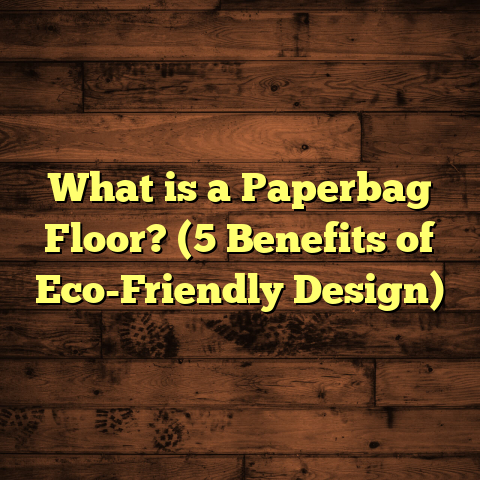What is Rubber Wood Flooring? (5 Benefits You Need to Know!)
Have you ever stepped into a room and felt instantly at ease, like everything just clicked? The kind of feeling that makes you want to kick off your shoes and stay awhile? For me, a big part of that vibe comes from the flooring. The right floor can change the entire mood of a home—from cold and sterile to warm and welcoming. But picking the perfect flooring is no easy task. There are so many options out there—hardwood, laminate, vinyl, tile—each with its own pros and cons. And if you want something that hits the sweet spot of style, durability, cost, and sustainability, it can quickly get overwhelming.
That’s exactly how I found myself intrigued by rubber wood flooring a few years back. I was working on a project where the client was deeply committed to using eco-friendly materials but had a modest budget. They wanted something natural and durable but affordable. Rubber wood was relatively new to them, and honestly, I hadn’t worked with it much either. Over time, I learned this material has some fantastic qualities you don’t hear about enough. It’s versatile, sustainable, and surprisingly sturdy for a wood that comes from trees grown primarily for latex.
If you’re curious about rubber wood flooring or thinking about it for your home, stick with me. I’m going to share what I’ve learned through hands-on experience, data-backed facts, real-world case studies, and practical tips you can use right away.
What is Rubber Wood Flooring?
Rubber wood flooring comes from the rubber tree species Hevea brasiliensis. These trees are primarily cultivated in tropical regions—think Southeast Asia and parts of South America—for latex production. Latex is the milky fluid tapped from the trees used mainly for making natural rubber products like tires, gloves, and balloons.
Here’s the key: after about 25-30 years of latex harvesting—the point when latex yield declines—the rubber trees are cut down. Instead of leaving all that wood to rot or burn as waste, manufacturers saw these trees into lumber. That lumber then gets processed into flooring planks.
This practice makes rubber wood flooring an eco-friendly choice since it uses plantation-grown trees that have already fulfilled their primary function. You’re not cutting down fresh hardwood forests but repurposing a byproduct of another industry.
The wood itself is light-colored—usually pale yellow or cream—and has a fine, straight grain with a smooth texture. It’s classified as a medium-density hardwood with durability that’s often underestimated. Once finished with stains or sealants, rubber wood can look very close to popular hardwoods like maple or beech.
I first came across rubber wood flooring on a renovation project for a family who wanted natural materials but couldn’t afford traditional hardwood. I was skeptical at first but quickly saw how good it looked once installed and finished properly. Since then, I’ve installed it in kitchens, living rooms, and even office spaces with great results.
Benefit 1: Eco-Friendly and Sustainable Flooring Option
If you care about the environment—and many homeowners are more conscious than ever before—rubber wood flooring has a strong case to make.
Let me explain why: The rubber tree plantations that supply this wood are managed to produce latex for decades before harvesting trees for lumber. This means no new forests are felled for this flooring; instead, it’s making use of an existing resource.
According to the Forest Stewardship Council (FSC), sustainable forestry practices in rubber plantations can reduce pressure on natural forests by around 40%. That’s huge considering how many people want to avoid contributing to deforestation.
I remember talking with one client who was very particular about sustainability. She told me she’d researched materials for weeks but found most hardwood floors either came from endangered forests or were prohibitively expensive when certified sustainably harvested. Rubber wood gave her peace of mind because it’s widely recognized as a plantation-grown timber with responsible sourcing.
Here’s something else interesting: rubber wood plantations also help sequester carbon while the trees grow—absorbing CO2 from the atmosphere. So while the trees are alive producing latex, they’re serving a crucial role in fighting climate change. When harvested responsibly, the wood becomes a renewable resource.
One study I came across showed that using plantation rubber wood reduces the embodied carbon footprint of flooring by roughly 30% compared to traditional hardwoods like oak or walnut sourced from natural forests.
If you’re looking to build or renovate with sustainability in mind, rubber wood flooring is definitely worth a look.
Benefit 2: Durability That Can Handle Real Life
When people hear about rubber wood being “soft” or “light,” they often doubt its ability to stand up to daily wear. But here’s what I’ve found from actual jobs: rubber wood is tougher than most expect.
It has a Janka hardness rating of about 980 pounds-force (lbf). The Janka test measures how resistant a wood species is to denting and wear. To put that into perspective:
| Wood Type | Janka Hardness Rating (lbf) |
|---|---|
| Rubber Wood | 980 |
| Red Oak | 1290 |
| Maple | 1450 |
| Cherry | 950 |
Rubber wood sits just below red oak but above cherry—which is commonly used in flooring. For everyday residential spaces like living rooms, bedrooms, and kitchens, it holds up well.
I learned this firsthand when installing rubber wood floors in a family home with young kids and playful dogs. Over four years of heavy foot traffic, toys dropped on the floor, and occasional spills, the floors only showed minor scuff marks—nothing deep or permanent. A light sanding and refinishing restored them beautifully.
The secret lies in proper finishing. When sealed with quality polyurethane or oil-based finishes, the surface becomes highly resistant to scratches and moisture—two major enemies of hardwood floors.
If you want flooring that balances durability and comfort underfoot (rubber wood is slightly softer than maple), this could be a winning choice.
Benefit 3: Affordable Without Sacrificing Style
Budgeting for home upgrades is often stressful. Hardwood floors can be expensive upfront—and sometimes clients have to choose cheaper alternatives like laminate or vinyl just to stay within budget.
Rubber wood flooring offers an attractive middle ground: it has the warmth and natural look of real wood but at a lower price point.
Material costs usually range between $3 and $7 per square foot depending on quality grades and finishes. Installation labor costs will be similar to other hardwoods if done by professionals.
Here’s an example from a project I managed recently: A homeowner wanted hardwood throughout their 1,200-square-foot main floor but had a budget capped at $10,000 for materials and installation combined. Oak was too pricey after quotes came back around $14,000 total. Rubber wood came in at $9,500 including installation—allowing them to get genuine wood floors without cutting corners elsewhere.
What surprised me most was how well the rubber wood floors looked after staining and finishing. The pale color accepts stains evenly—whether going for light gray tones or rich dark browns—and the straight grain adds subtle texture without being busy. It’s versatile enough for many design schemes.
Saving 30% or more compared to traditional hardwood opens opportunities for upgrading cabinets or appliances within the same budget—something clients always appreciate.
Benefit 4: Design Flexibility You Will Love
I want to talk about style because flooring isn’t just functional—it sets the tone for your entire space.
Rubber wood’s natural light color provides an airy and open feel that works great in smaller rooms or those with limited natural light. But if you prefer darker floors? No problem! Rubber wood takes stain beautifully due to its uniform grain and smooth surface.
I’ve had clients choose everything from soft whitewash finishes for Scandinavian-inspired interiors to deep espresso stains for cozy rustic vibes—all on rubber wood floors.
Because it doesn’t have heavy knots or uneven grain like some other woods (pine comes to mind), you get a clean canvas that won’t compete with your furniture or decor.
One project I remember well was a boutique office space where the client wanted modern elegance without feeling cold. We went with a medium walnut stain on rubber wood flooring paired with matte black metal accents—a combo that looked high-end but stayed affordable.
If you’re into painting floors (yes, some people do!), rubber wood also accepts paint well for creative patterns or color blocking since it holds finishes tightly.
Benefit 5: Simple Maintenance That Keeps Floors Looking New
Floors get dirty. They get scratched. They get worn down over time—that’s life in any home or commercial space.
Rubber wood floors shine in how easy they are to maintain day-to-day:
- Sweeping or vacuuming weekly keeps dust and grit off surfaces.
- Damp mopping with mild soap solutions removes spills and grime without damaging finishes.
- Avoid harsh chemicals or abrasive scrubbers that can strip sealants.
- If scratches occur, light sanding and refinishing restores smoothness thanks to the wood’s fine texture.
- Keep humidity levels between 35-55% indoors to prevent warping or shrinking (this applies broadly to hardwoods).
Over many years installing these floors, I’ve seen how easily rubber wood can be refreshed with simple maintenance compared to more temperamental woods like teak or mahogany that require specialized care products.
One homeowner shared how their kitchen rubber wood floor looked practically brand new after five years just by following basic cleaning guidelines I provided during installation.
A Case Study: The Johnson Family Renovation
Early in my career installing rubber wood flooring was this project with the Johnson family—a young couple with two kids who wanted sustainable materials but needed affordability.
They initially leaned toward engineered oak but balked at the cost once estimates came in around $15K for materials plus installation on their 1,000-square-foot space.
I suggested they consider rubber wood flooring as an alternative after explaining its eco-friendly sourcing and durability. They were hesitant but agreed to test samples at home.
After seeing how well the samples matched their furniture and feeling the warmth underfoot during visits, they committed.
The finished floor was stunning—a natural honey tone with subtle grain patterns that brightened rooms without overpowering them. The Johnsons were thrilled with both look and feel.
Two years later when I visited again for another job nearby, they told me how easy cleanup was—even with kids spilling juice—and how their floors still looked amazing despite heavy foot traffic.
This experience showed me personally that rubber wood flooring can meet real family needs while respecting budgets and values.
How Rubber Wood Compares To Other Flooring Types
Sometimes comparing options side by side helps clarify choices:
| Flooring Type | Durability | Cost per Sq Ft | Eco-Friendliness | Maintenance Ease | Design Flexibility |
|---|---|---|---|---|---|
| Rubber Wood | Medium-High | $3 – $7 | High (plantation) | Easy | High |
| Red Oak | High | $5 – $10 | Medium | Moderate | High |
| Bamboo | Medium | $2 – $6 | High | Moderate | Medium |
| Laminate | Low-Medium | $1 – $4 | Low | Easy | Medium |
| Vinyl | Low | $2 – $5 | Low | Easy | Medium |
You see that rubber wood offers a great balance between price, durability, eco-friendliness, and aesthetics compared to hardwoods and synthetic alternatives.
Practical Tips for Choosing and Installing Rubber Wood Flooring
If you decide rubber wood flooring fits your needs, here are some pointers:
- Inspect Samples: Look closely at color variations and grain before ordering large quantities.
- Confirm Certification: Ask suppliers for FSC or similar certification proving sustainable sourcing.
- Select Finish Wisely: Polyurethane finishes offer durability; natural oils enhance warmth but may require more upkeep.
- Acclimate Wood: Let planks sit in your home environment for several days before installation to adjust moisture content.
- Hire Experienced Installers: Proper installation prevents gaps and uneven wear.
- Plan Waste Factor: Order 5-10% extra material for cuts and mistakes.
- Maintain Climate Control: Use humidifiers/dehumidifiers seasonally if needed.
- Use Protective Pads: Under furniture legs to avoid dents.
- Clean Gently: Avoid wet mops or harsh cleaners.
- Schedule Periodic Refinishing: Every 7-10 years depending on traffic.
My Final Thoughts on Rubber Wood Flooring
From my experience installing dozens of projects using this material over the last decade, rubber wood flooring has proven itself as:
- A responsible choice for eco-conscious homeowners
- Durable enough for busy family life
- Stylish enough for varied design tastes
- Affordable without feeling cheap
- Easy to live with through routine maintenance
Whether you want pale natural boards for Scandinavian minimalism or stained dark planks for rustic charm—rubber wood delivers.
If you’re ready for floors that do more than just cover space—floors that reflect values and personality—I highly recommend giving rubber wood serious consideration.
Got questions about finishes? Curious if it suits your specific climate? Need help finding reliable suppliers? Just ask—I’m here to help!
Rubber wood might not be your first thought when considering hardwood floors—but it could well be your best one yet.





